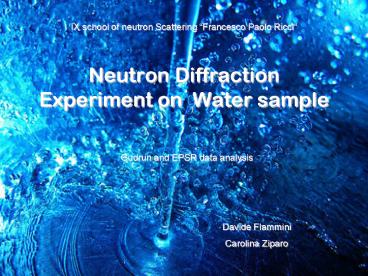Neutron Diffraction Experiment on Water sample - PowerPoint PPT Presentation
1 / 24
Title:
Neutron Diffraction Experiment on Water sample
Description:
IX school of neutron Scattering Francesco Paolo Ricci Neutron Diffraction Experiment on Water sample Gudrun and EPSR data analysis Davide Flammini – PowerPoint PPT presentation
Number of Views:195
Avg rating:3.0/5.0
Title: Neutron Diffraction Experiment on Water sample
1
Neutron Diffraction Experiment on Water sample
IX school of neutron Scattering Francesco Paolo
Ricci
Gudrun and EPSR data analysis
Davide Flammini Carolina Ziparo
2
Contents
- Sample and instrument
- Structure factors definition
- Data analysis
- Conclusions
3
The samplewater T45 ºC
- Neutron Diffraction experiment
-
- Instrument SANDALS at ISIS neutron facility
- (pulsed source)
4
SANDALS
Small Angle Neutron Diffractometer for Amorphous
and Liquid Samples Using SANDALS it is possible
to measure the static structure factor, S(Q), of
a material over a wide range of momentum
transfers
Incident Wavelength 0.05 to 4.5 Å
Q-range 0.1 to 50 Å
Moderator Liquid methane at 110K
Incident Flight Path 11m
Final Flight Paths 0.75m to 4.0m
5
(No Transcript)
6
How can we obtain Saß(Q)?
- We have to perform an isotopic substitution of H
with D - We have 3 Saß(Q) to evaluate
- We need 3 different concentration of D
- H2O (0)
- HDO (50)
- D2O (100)
7
How we can perform the data analysis?
- Can subtraction
- MC simulation to correct the inelastic
contribution - Start with EPSR to refine the potential
- Start with accumulation
- Analysis Results
- Conclusions
8
Can Subtraction
- Can subtraction to obtain only the sample signal
- In principle each can is different although is
made of the same material - So we have to measure each of them
9
Can Signals
- H2O
- D2O
- HDO
I arb. U.
QÅ-1
Sample Can Thickness (cm)
H2O 0.095
D2O 0.090
HDO 0.094
Nominal thickness 0.1 cm
10
Inelastic Correction
bD 6.67 fm bH -3.74 fm
- H2O
- D2O
- HDO
I arb. U.
QÅ-1
11
MC simulation to correct the inelastic
contribution
- We start an EPSR simulation without potential
refinement
- We used the SPC-E (Simple Point Charge Enhanced)
reference potential
Atom e (KJ/mol) s (Å) q(e)
O 0.65 3.166 -0.8476
H 0 0 0.4238
12
MC simulation to correct the inelastic
contribution
H2O
HDO
D2O
QÅ-1
QÅ-1
QÅ-1
13
Start with EPSR to refine the potential
- Cubic box with 500 water molecules
- Box edge of 25 Å
- We switched on the referential potential
refinement of the system used for the MC
simulation - Wait for the system to thermalize
14
Start with accumulation
- Once the system reach the energy minimum we start
accumulating configurations (put iinit0) - EPSR makes an average of equivalent
configurations of the system
Increase of H bonds!!
15
Analysis Results
Fit and difference with experimental data
Fit and experimental data
The differences have no structures
16
Analysis Results
Partial Pair distribution function g(r)
T 45 oC
- The peaks are at the same position then the water
at ambient T - There are no visible difference on the structure
respect to ambient T
17
Analysis Results
Empirical potential
- The correction to the reference potential is very
small
18
Analysis Results
Angle distribution function
- The O-H-O maximum at 1800 represents the H bond
- The O-O-O maximum around 1000 describes the
tetrahedral structure
19
Analysis Results
Spatial density function
20
Analysis Results
Coordination Number
4.2
1.9
5.1
21
Analysis Results
Water Percolation function
N 3.9
- There is the evidence of the formation of a big
cluster of almost all molecules of the box. We
can say that the water is percolating
22
Conclusions
We carried out a data analysis on a sample of
water at 45 0C using Gudrun and EPSR
- At this T the water still present an ordered
tetrahedral structure - There is the evidence of the presence of a lot of
H bonds - Fitting our data with a box of 500 molecules we
can see a big cluster - of almost all the molecules
Percolation - The water structure do not show evident
differences with ambient T water
23
Acknowledgements
- Our teachers Silvia Imberti and
- The IX school of neutron Scattering
- Francesco Paolo Ricci
- All the speakers
- The band of Baretto
Rosaria Mancinelli
24
The end
Thank you for your attention!































